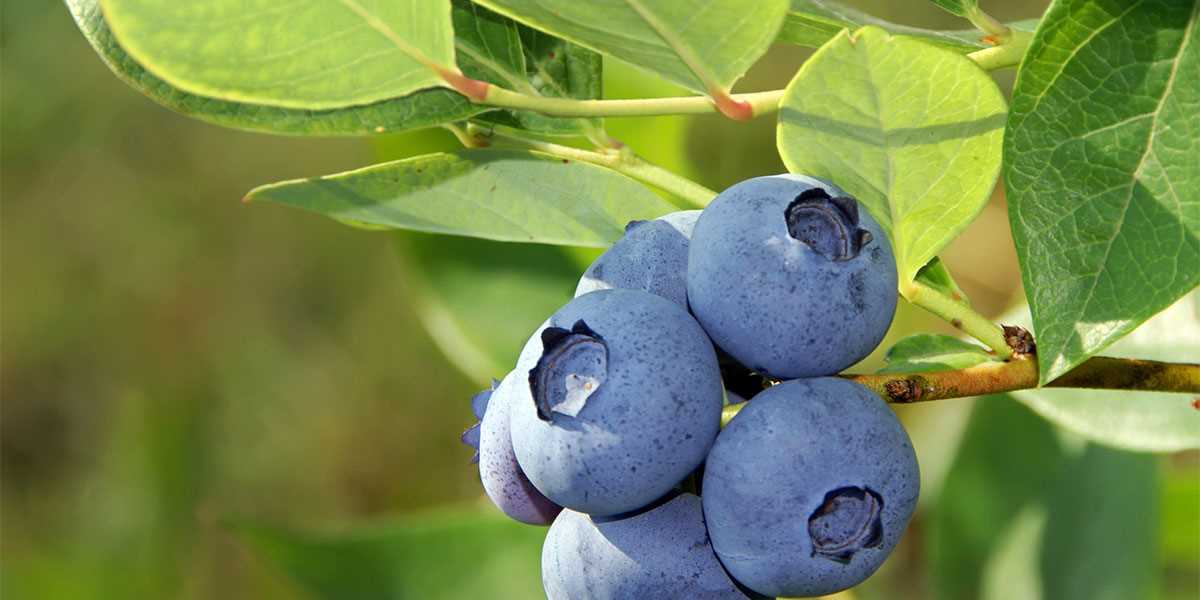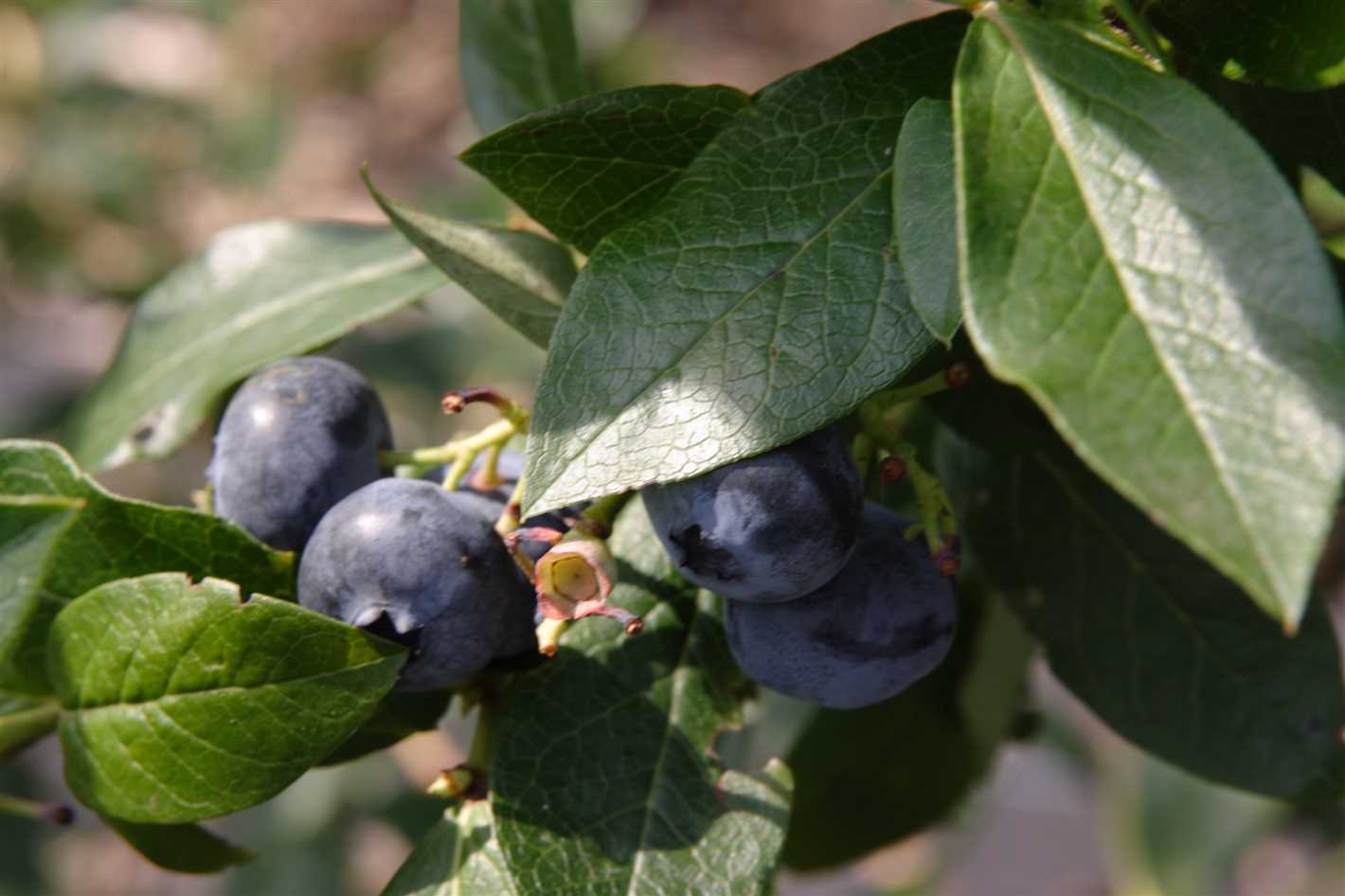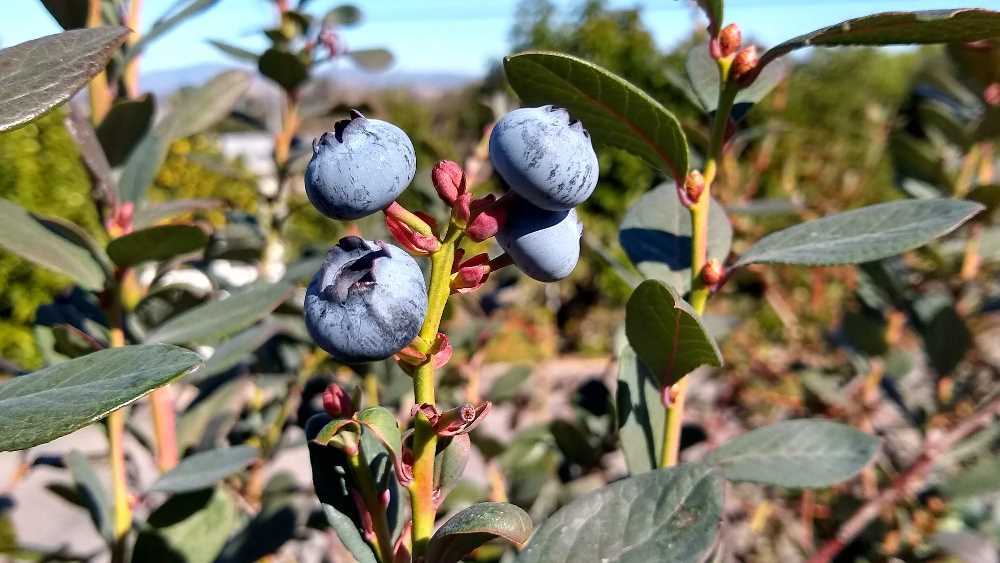- Watering Blueberries – The Key to Successful Cultivation
- The Watering Needs of Blueberries
- Watering Tips for Blueberries
- Conclusion
- Understanding the Water Needs of Blueberries
- Watering frequency
- Watering method
- Watering amount
- Monitoring soil moisture
- Factors Affecting Watering Requirements
- 1. Soil Type
- 2. Climate
- 3. Plant Size and Age
- 4. Seasonal Variations
- 5. Mulching
- 6. Rainfall
- 7. Container vs. In-Ground Planting
- 8. Observing Plant Symptoms
- Conclusion
- Optimal Timing for Watering Blueberries
- 1. Morning Watering
- 2. Avoid Watering at Night
- 3. Water During Dry Spells
- 4. Mulch to Retain Moisture
- 5. Adjust watering based on stage
- Choosing the Right Watering Method
- 1. Drip Irrigation
- 2. Soaker Hoses
- 3. Sprinkler Systems
- 4. Hand Watering
- 5. Mulch and Watering Trays
- 6. Considerations for Container-Grown Blueberries
- Preventing Overwatering: Tips and Tricks
- 1. Understand the water requirements of blueberries
- 2. Check soil moisture regularly
- 3. Water early in the day
- 4. Use mulch
- 5. Adjust watering during rainy periods
- 6. Use the right watering technique
- Monitoring Soil Moisture Levels
- Other Considerations for Proper Watering
- Question-answer:
- How often should I water blueberries?
- What is the best time of day to water blueberries?
- Why is proper watering important for blueberries?
- Can I overwater my blueberries?
- What is the best method for watering blueberries?
- Should I water blueberries during the winter?
- How can I tell if my blueberries need water?
- Video: 5 Tips to Grow Lots of Blueberries
Growing blueberries is a popular and rewarding endeavor for many gardeners. These colorful and delicious berries not only provide a tasty treat, but they also offer numerous health benefits. However, blueberries have specific requirements when it comes to watering, and understanding these needs is crucial to their successful cultivation.
One important factor to consider when watering blueberries is the frequency of irrigation. Blueberries prefer slightly acidic soil and should be watered regularly to maintain moisture levels. However, overwatering can lead to waterlogged soil, which can be detrimental to the plants’ root system. It is recommended to water blueberries deeply, allowing the water to penetrate the root zone, but avoid excessive watering.
Another consideration for proper watering of blueberries is the timing of irrigation. It is best to water blueberries in the early morning to avoid evaporation and to give the plants time to dry before nightfall. Wet foliage during the night can increase the risk of disease and fungal infections. Additionally, watering in the morning allows the plants to take up water during the day, aiding in their overall growth and development.
When it comes to the method of watering, drip irrigation or soaker hoses are ideal for blueberries. These methods provide a slow and steady supply of water directly to the plants’ root zone, minimizing water loss through evaporation. It is essential to ensure that the water reaches the entire root system by positioning the irrigation system correctly and adjusting the water flow accordingly.
Overall, watering blueberries properly is essential to ensure their health and productivity. By understanding the specific requirements of this crop, such as frequency, timing, and method of irrigation, gardeners can provide the optimal conditions for their blueberry plants to thrive. With the right approach to watering, you can enjoy a bountiful harvest of these delicious and nutritious berries!
Watering Blueberries – The Key to Successful Cultivation
Blueberries are a unique fruit that require a special approach when it comes to watering. Proper watering is crucial for the successful cultivation of blueberries, as it directly affects their growth, fruit production, and overall health. In this article, we will discuss the importance of watering blueberries and provide some tips for ensuring their water needs are met.
The Watering Needs of Blueberries
Blueberries have specific water requirements that differ from other fruit plants. They prefer moist, well-drained soil, and their roots are shallow and fibrous, making them more susceptible to drying out. Additionally, blueberries have a relatively low tolerance for drought and can suffer from water stress if not watered adequately.
In general, blueberries require about 1 to 1.5 inches of water per week, including rainfall. However, this amount can vary depending on factors such as soil type, weather conditions, and the stage of plant growth. During the summer months when blueberries are actively growing and producing fruit, they may require more frequent watering to meet their increased water demands.
Watering Tips for Blueberries
To ensure the proper watering of your blueberries, consider the following tips:
- Provide a Consistent Water Supply: Blueberries prefer consistent moisture levels, so it’s important to maintain a regular watering schedule. Avoid allowing the soil to completely dry out between watering sessions, as this can stress the plants and negatively impact their growth.
- Avoid Overwatering: While it’s important to keep the soil consistently moist, overwatering can be detrimental to blueberries. Excessive moisture can lead to root rot and other diseases. Monitor the moisture levels by checking the soil’s dampness before watering and adjust accordingly.
- Water Deeply: When watering blueberries, aim to provide a deep soaking rather than light surface watering. This encourages the roots to grow deeper into the soil, making the plants more resilient to drought conditions.
- Mulch to Retain Moisture: Adding a layer of organic mulch around the base of the blueberry plants can help retain soil moisture and prevent weed growth. This will reduce the need for frequent watering and help maintain a more consistent soil moisture level.
- Consider Drip Irrigation: Drip irrigation is an effective watering method for blueberries as it delivers water directly to the roots, minimizing water wastage and reducing the risk of foliar diseases. It also prevents water from splashing onto the foliage, which can promote fungal growth.
Conclusion

Watering blueberries properly is essential for their successful cultivation. By providing consistent moisture, avoiding overwatering, and employing techniques such as deep watering and mulching, you can ensure that your blueberries thrive and produce a bountiful harvest. Remember to monitor the soil moisture levels regularly and adjust your watering schedule as needed to meet the specific needs of your blueberry plants.
Understanding the Water Needs of Blueberries
Proper watering is crucial for the health and productivity of blueberry plants. Blueberries have specific water requirements that need to be understood in order to achieve optimal growth and fruit production.
Watering frequency
Blueberries prefer a consistently moist soil, but not one that is waterlogged. They have shallow root systems and are susceptible to root rot, so it is important to avoid overwatering. The frequency of watering will depend on several factors:
- Soil type: soils that drain well may require more frequent watering compared to heavy clay soils.
- Weather conditions: hot, dry weather will increase the water needs of blueberries.
- Plant age: younger plants may need more frequent watering until their root systems establish.
Watering method
The most effective way to water blueberries is through drip irrigation or soaker hoses. These methods deliver water directly to the root zone, minimizing evaporation and reducing the risk of fungal diseases. Overhead sprinklers should be avoided as they can promote the spread of diseases and waste water through evaporation.
Watering amount
Blueberries generally require about 1 to 2 inches of water per week, depending on weather conditions. It is important to water deeply, ensuring that the water reaches the full depth of the root system. A layer of organic mulch around the plants can help to retain moisture and reduce the need for frequent watering.
Monitoring soil moisture
Regularly monitoring the moisture level of the soil is essential for proper watering. Stick your finger about an inch into the soil to check for moisture. If it feels dry at that depth, it’s time to water. Using a soil moisture meter can also be helpful in determining when to water.
| Signs of under-watering: | Signs of overwatering: |
|---|---|
|
|
Remember, it is better to slightly underwater than to overwater blueberries. With proper watering practices, you can help your blueberry plants thrive and produce a bountiful harvest.
Factors Affecting Watering Requirements
Several factors influence the watering requirements of blueberries. Understanding these factors will help you properly water your blueberry plants and ensure their health and productivity.
1. Soil Type
The soil type plays a crucial role in determining the watering needs of blueberries. Blueberries thrive in well-draining acidic soil with a pH level between 4.5 and 5.5. Sandy soil drains more quickly, requiring more frequent watering, while heavy clay soil holds water for longer periods, reducing the need for frequent watering.
2. Climate
The climate of your region also affects the watering requirements of blueberries. In hot and dry climates, blueberry plants may need more frequent watering to prevent drought stress. In cooler and more humid regions, watering intervals may be less frequent.
3. Plant Size and Age

The size and age of the blueberry plants also impact their watering needs. Young plants and newly transplanted blueberries require more frequent watering as their root systems are not yet well-established. Larger and mature plants have larger root systems that can access more soil moisture and may require less frequent watering.
4. Seasonal Variations
The watering requirements of blueberries vary throughout the growing season. During the active growth phase, which is spring and early summer, blueberries need more water to support their growth and fruit development. During dormancy in winter, they require less water as they are not actively growing.
5. Mulching
The use of mulch around blueberry plants can help conserve soil moisture and reduce water evaporation. Applying a layer of organic mulch, such as wood chips or pine needles, around the base of the plants helps maintain soil moisture levels, reducing the frequency of watering.
6. Rainfall

The amount and frequency of rainfall in your area also affect the watering requirements of blueberries. If your region receives adequate rainfall, you may need to water less frequently. However, during dry periods or droughts, supplemental watering may be necessary to ensure the plants receive sufficient moisture.
7. Container vs. In-Ground Planting
The watering requirements may differ for blueberry plants grown in containers compared to those planted in the ground. Container-grown blueberries dry out more quickly and may require more frequent watering. In-ground plants benefit from natural soil moisture but may still need additional watering during dry spells.
8. Observing Plant Symptoms
Observing the plants themselves is an important factor in determining their watering needs. Wilting or drooping leaves are signs of under-watering, while yellowing or brown leaves may indicate over-watering. Monitoring plant health and adjusting watering accordingly is key to maintaining optimal moisture levels.
Conclusion
Proper watering of blueberries is crucial for their overall health and productivity. By considering factors such as soil type, climate, plant size and age, seasonal variations, mulching, rainfall, planting method, and plant symptoms, you can ensure that your blueberries receive the appropriate amount of water to thrive and produce delicious berries.
Optimal Timing for Watering Blueberries
Proper watering is essential for the healthy growth and development of blueberries. Blueberries have specific water requirements, and timing is crucial to ensure optimal hydration. Here are some guidelines for when to water your blueberry plants:
1. Morning Watering
It is recommended to water your blueberries in the morning, preferably between 6 am and 10 am. This allows the plants to absorb the moisture before the temperature rises and evaporation increases. Morning watering also helps prevent the development of fungal diseases, as the foliage will have sufficient time to dry out during the day.
2. Avoid Watering at Night
Avoid watering your blueberries in the evening or at night. When the temperatures drop in the evening, the excess moisture can linger on the foliage and promote the growth of fungi, such as powdery mildew and leaf spot. Moist conditions during the night increase the risk of diseases, so it’s best to avoid watering at this time.
3. Water During Dry Spells

During dry spells or periods of drought, it is important to provide your blueberry plants with sufficient water. Blueberries have shallow roots, and they require consistent moisture to thrive. Check the soil moisture regularly and water whenever the top 1 to 2 inches of soil feels dry. Apply water slowly and deeply to ensure it reaches the root zone.
4. Mulch to Retain Moisture
Applying a layer of mulch around your blueberry plants can help retain soil moisture. Mulch reduces evaporation and helps regulate soil temperature, which is beneficial for blueberries. Use organic mulch such as wood chips, straw, or pine needles. Apply a 2 to 4-inch layer around the base of the plants, keeping it a few inches away from the stems to prevent rot.
5. Adjust watering based on stage
The watering needs of blueberries can vary depending on their growth stage. During establishment, young plants require more frequent watering to ensure proper root development. As the plants mature, you can reduce the frequency but maintain deep watering to encourage root growth.
By following these guidelines, you can ensure that your blueberry plants receive the optimal amount of water at the right time. Proper watering will promote healthy growth, abundant fruiting, and contribute to the overall success of your blueberry crop.
Choosing the Right Watering Method
When it comes to watering blueberries, there are several methods you can choose from. The right watering method will depend on a variety of factors, including the climate, soil type, and the stage of growth of your blueberry plants.
1. Drip Irrigation
Drip irrigation is one of the most efficient ways to water blueberries. It involves the use of a series of tubes or drip lines that deliver water directly to the root zone of the plants. This method helps to conserve water by reducing evaporation and runoff. It also minimizes the risk of overwatering, which can lead to root rot.
2. Soaker Hoses
Soaker hoses are another popular method for watering blueberries. These hoses release water slowly and directly into the soil, allowing it to penetrate deeply and reach the roots. Soaker hoses are easy to install and can be connected to a timer for automated watering.
3. Sprinkler Systems

Sprinkler systems can be used to water blueberries, but they are not the most efficient option. This method relies on overhead sprinklers that distribute water over a larger area. While it can provide uniform coverage, there is a higher risk of water loss due to evaporation and runoff. Additionally, wet leaves can increase the chances of disease and fungal issues.
4. Hand Watering
If you have a small number of blueberry plants or want to closely monitor the watering process, hand watering can be an effective method. This involves using a watering can or hose with a gentle spray attachment to water the plants by hand. While it allows you to control the amount of water applied, it can be time-consuming, especially if you have a large blueberry patch.
5. Mulch and Watering Trays
Mulching around your blueberry plants can help retain moisture in the soil and reduce the frequency of watering. This method involves placing a layer of organic mulch, such as wood chips or straw, around the base of the plants. Watering trays can also be used by filling them with water and allowing the plants to absorb moisture through their roots. Both methods help to maintain consistent soil moisture levels.
6. Considerations for Container-Grown Blueberries
If you are growing blueberries in containers, the watering method may need to be adjusted. Container-grown plants tend to dry out more quickly than those grown in the ground, so regular monitoring and more frequent watering may be necessary. Watering from the bottom by placing the pots in a tray or saucer filled with water can help ensure thorough hydration.
Ultimately, the choice of watering method will depend on your specific circumstances and preferences. It is important to strike a balance between providing enough water for your blueberry plants to thrive while avoiding overwatering. Regularly monitor the moisture levels in the soil and adjust your watering schedule as needed to keep your blueberries happy and healthy.
Preventing Overwatering: Tips and Tricks
Overwatering can be detrimental to blueberry plants, as it can lead to root rot, nutrient leaching, and poor growth. To ensure the health and vitality of your blueberry plants, it is essential to prevent overwatering. Here are some tips and tricks to help you avoid overwatering your blueberries:
1. Understand the water requirements of blueberries
- Blueberries have shallow root systems and prefer well-drained soil.
- They require consistent moisture, but the soil should never be waterlogged.
- Watering should be done deeply and infrequently to encourage the roots to grow deeper and develop a strong foundation.
- Avoid frequent shallow watering, as it can promote shallow root growth and make the plants more susceptible to drought.
2. Check soil moisture regularly
- Use your finger to determine if the top inch of soil is dry before watering.
- If the soil feels moist, wait a few more days before watering to prevent overwatering.
- Invest in a soil moisture meter to accurately measure the moisture level in the soil.
3. Water early in the day
- Watering in the morning allows the plants to take up the moisture before the heat of the day evaporates it.
- Watering in the evening can increase the risk of disease, as the foliage remains wet for a longer period.
4. Use mulch
- Apply a layer of organic mulch around the base of the plants to help retain soil moisture.
- Mulch also helps to prevent weed growth and keeps the soil temperature stable.
- Make sure to keep the mulch a few inches away from the stems of the blueberry plants to prevent rotting.
5. Adjust watering during rainy periods
- If there is adequate rainfall, reduce or even stop watering temporarily.
- Monitor the soil moisture and only water if necessary.
6. Use the right watering technique
- Avoid using overhead sprinklers, as they can wet the foliage and increase the risk of disease.
- Instead, use drip irrigation or soaker hoses to water the plants directly at the root zone.
By following these tips and tricks, you can prevent overwatering and ensure the health and productivity of your blueberry plants. Remember to closely monitor the soil moisture and adjust your watering practices accordingly. Happy gardening!
Monitoring Soil Moisture Levels
Proper watering of blueberries is essential for their health and productivity. To ensure that you are providing the right amount of water, it is important to monitor the soil moisture levels regularly. This will help you determine when and how much water to give to your blueberry plants.
There are several methods for monitoring soil moisture levels:
- Visual Inspection: One simple way to check soil moisture is by visually inspecting the soil. Take a close look at the color and texture of the soil. If it appears dry and crumbly, it is a sign that the soil may be too dry and in need of watering. On the other hand, if the soil looks wet and muddy, it indicates excessive moisture and watering should be minimized.
- Touch Test: Another way to assess soil moisture is by using the touch test. Gently press your finger into the soil up to the second knuckle. If the soil feels moist and sticks to your finger, it is adequately hydrated. However, if the soil feels dry and does not stick to your finger, it is time to water the plants.
- Soil Moisture Meter: A more accurate method is to use a soil moisture meter. This device measures the moisture content in the soil and gives you a precise reading. Insert the probe of the meter into the soil and check the reading. If the moisture level is below the recommended range, it is time to water the blueberries.
- DIY Moisture Sensor: If you don’t have a soil moisture meter, you can create a DIY moisture sensor using a wooden dowel or a metal rod. Push the dowel or rod into the soil and leave it for a few minutes. When you pull it out, the presence of moisture on the dowel or rod indicates that the soil is sufficiently watered.
Remember that overwatering can be as harmful as underwatering for blueberry plants. Properly monitoring soil moisture levels will help you strike the right balance in watering, ensuring the health and productivity of your blueberry bushes.
Other Considerations for Proper Watering
In addition to the frequency and timing of watering, there are a few other considerations to keep in mind when watering your blueberries:
- Soil Drainage: Blueberries prefer well-draining soil. If your soil is heavy and retains water, consider amending it with organic matter to improve drainage.
- Water Quality: Blueberries are sensitive to the pH and mineral content of water. They thrive in slightly acidic soil, so using rainwater or filtered water may be beneficial.
- Drip Irrigation: Using drip irrigation systems can be an effective way to deliver water directly to the roots while minimizing water waste through evaporation and runoff.
- Mulching: Applying a layer of organic mulch around the base of your blueberry plants can help regulate soil moisture levels, reduce weed competition, and prevent soil erosion.
Remember that every blueberry plant is unique, and finding the right watering routine may require some experimentation and observation. Pay attention to the signs of water stress or overwatering, such as drooping leaves or yellowing foliage, and adjust your watering practices accordingly.
Question-answer:
How often should I water blueberries?
Blueberries should be watered regularly, about once or twice a week, ensuring that the soil is consistently moist but not waterlogged.
What is the best time of day to water blueberries?
The best time of day to water blueberries is in the morning, as this allows the foliage to dry out during the day, reducing the risk of fungal diseases.
Why is proper watering important for blueberries?
Proper watering is important for blueberries because they have shallow roots and require consistent moisture to thrive. Inadequate watering can lead to poor fruit development and plant stress.
Can I overwater my blueberries?
Yes, overwatering blueberries can be detrimental to their health. It can lead to root rot and other fungal diseases. It’s important to maintain a balance and avoid waterlogging the soil.
What is the best method for watering blueberries?
The best method for watering blueberries is using a drip irrigation system or a soaker hose. This allows for slow and deep watering, ensuring that the roots receive adequate moisture without causing soil compaction.
Should I water blueberries during the winter?
During the winter, blueberries require less water as they are in a dormant state. However, if the weather is particularly dry, it is recommended to provide some water to prevent dehydration.
How can I tell if my blueberries need water?
You can tell if your blueberries need water by checking the moisture level of the soil. Stick your finger about an inch into the soil, and if it feels dry, it’s time to water. Additionally, the leaves may wilt if the plant is lacking water.







